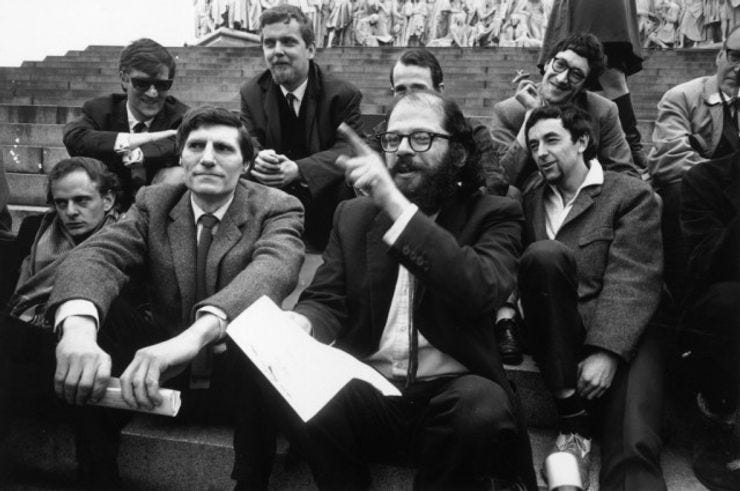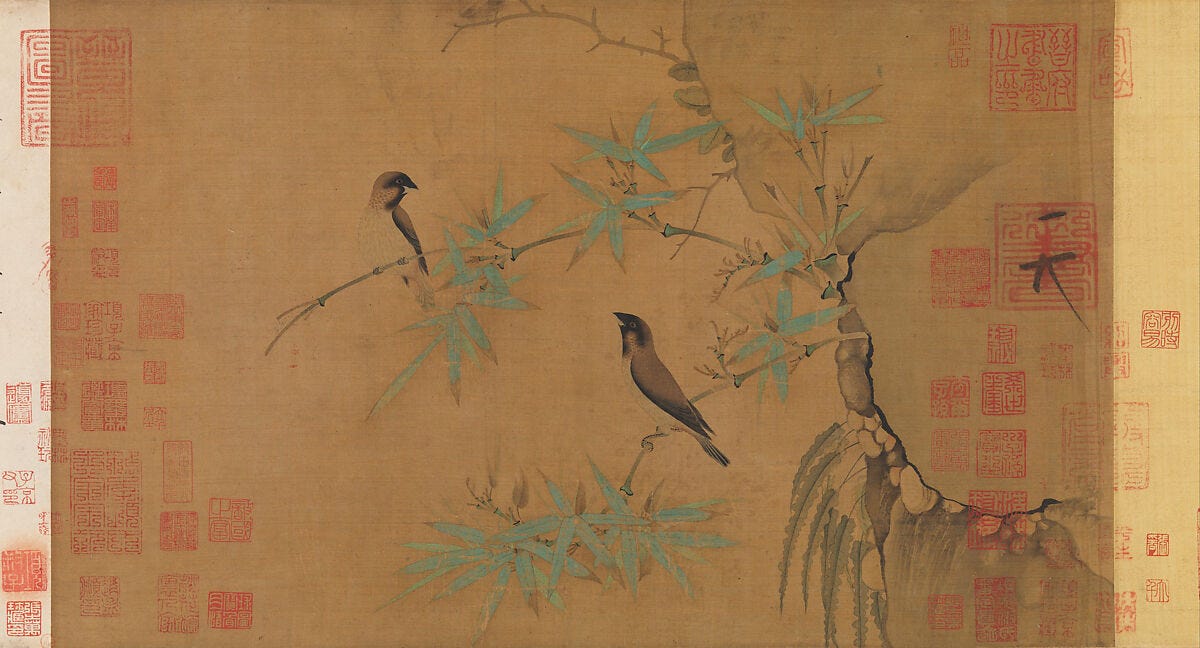Although shocking for its time, Beat poetry was not unanticipated. It developed from modernist antecedents it readily acknowledged, most significantly William Carlos Williams. Among the original Imagists, Williams consciously broke with his European counterparts to achieve a distinctly American voice in modernist poetry. Williams’s voice gave the Beat poets a vehicle well-suited to express the solipsistic inner rebellion that characterizes their poetry – a voice that would have profound impact on American poetry through the present.
I. Historical Context
The Beat Generation coalesced in the decade following the end of World War II – a time of fear and paranoia. The wake of a major war ordinarily sees a bleak outlook on life – for example, the decade or so following the Napoleonic Wars or the years following World War I. But the end of World War II ushered in the age of nuclear warfare, and the Soviet Union’s detonation of its first atomic bomb in 1949 initiated the four-decade standoff of the Cold War, with its ever-present threat of nuclear annihilation.
In the United States, the Cold War triggered an official reaction, supported by Democrat and Republican officeholders alike, to the perceived internal threat that communism posed. The House Committee on Un-American Activities (HUAC), constituted in 1945, was charged with investigating suspected threats of subversion or propaganda attacking “the form of government as guaranteed by our Constitution.” Most famously in 1947, the committee conducted nine days of hearings on Communist Party influence in the Hollywood motion picture industry, resulting in the major studios boycotting some 300 artists, including Charlie Chaplin and Orson Welles.
The result of this official scrutiny was a counter-reaction among America’s artistic community to the official reaction against communism. Even artists who were not card-carrying communists resented the government censorship as a restriction on expression more generally, and lived in fear that their own expression would result in them being hauled before a Congressional committee to testify.
This attitude is perfectly captured by Tennessee Williams in an essay originally published in the New York Sun in 1948, under the title “On the Art of Being a True Non-Conformist,” which he later republished as the introduction to his one-act play “27 Wagons Full of Cotton” under the title “Something Wild . . . .” (Williams, xii.)
Williams begins his essay by describing a visit he had with a successful community theatre group and noting, “It seemed all so respectable. . . . The men in their conservative business suits with their neat hair-cuts and highly polished shoes could have passed for corporation lawyers and the women, mostly their wives, were impeccably lady-like.” (Id., vii.) He counters this observation with his thesis: “art is a kind of anarchy, and the theater is a province of art.” The problem with the scene was that it was missing “is a benevolent anarchy . . . in the sense of constructing something which is missing, and what it constructs may be merely criticism of things as they exist.” (Id.)
Williams then states his criticism of his society:
Today we are living in a world which is threatened by totalitarianism. The Fascist and the Communist states have thrown us into a panic of reaction. Reactionary opinion descends like a ton of bricks on the head of any artist who speaks out against the current of prescribed ideas. We are all under wraps of one kind or another, trembling before the spectre of investigating committees and even with Buchenwald in the back of our minds when we consider whether or not we dare to say we were for Henry Wallace. Yes, it is as bad as that. (Id., xi.)
After noting, “And yet it isn’t really as bad as that. America is still America, democracy is still democracy,” (Id.) Williams concludes with a call to arms:
For God’s sake let us defend ourselves against whatever is hostile to us without imitating the thing which we are afraid of!
Community theaters have a social function and it is to be that kind of an irritant in the shell of their community. Not to conform, not to wear the conservative business suit of their audience, but to let their hair grow long and even greasy, to make wild gestures, break glasses, fight, shout, and fall downstairs! When you see them acting like this—not respectably, not quite decently, even!—then you will know that something is going to happen in that outfit, something disturbing, something irregular, something brave and honest.
The biologist will tell you that progress is the result of mutations. Mutations are another word for freaks. For God’s sake let’s have a little more freakish behavior—not less. (Id., xii.)
According to Williams, the “something brave and honest” can only result from the “benevolent anarchy” of the arts world, which is incompatible with “the conservative business suit.” To him, only anarchy produces true art. Everything else is a reaction – indeed, it is totalitarian. This is the view that the Beat poets would ultimately express through their work and through their very lives.
But the regime of official repression against which Williams railed was only a prim and proper veneer, beneath which a revolution in social norms was already brewing. In 1946, the pediatrician Dr. Benjamin Spock published The Common Sense Book of Baby and Child Care, which was the first major work to apply psychoanalytical techniques to child-rearing. Its call for parents simply to “trust their instincts” immediately influenced a generation of parents rearing their children in the post-war “baby boom.” In 1948, Dr. Alfred Kinsey of Indiana University published Sexual Behavior in the Human Male, which he followed in 1953 with Sexual Behavior in the Human Female, which established the field of sexology as an academic subject. In 1953, Playboy, which would hugely influence the purveyance of sex to the public, launched its publication in Chicago. And in 1957, the United States Supreme Court in Roth v. United States narrowed the long-standing definition of obscenity. (354 U.S. 476.) Contrary to the popular image of the staid and conservative 1950’s, the reality was that the revolution that would burst forth in full flamboyance in the 1960’s was already underway.
The birth of Beat Poetry fits right into this trend, with Allen Ginsburg’s 1955 recitation of Howl regarded as its official beginning. As much as the Beat poets would epitomize Tennessee Williams’s call to ditch “the conservative business suit” and “let their hair grow long and even greasy” and for “a little more freakish behavior,” they were responding to his call of rebellion along with society at large.
Indeed, the Beat poets were very much products of their Modernist predecessors. It was another Williams that would serve as their literary catalyst in a much more profound way.
II. The Precursor: William Carlos Williams
William Carlos Williams (1883-1963) was one of the leading pioneers of the Imagist movement, along with Ezra Pound and H.D. (“William Carlos Williams,” para. 1.) Unlike Pound and other American expatriate poets, however, he lived a remarkably conventional life, practicing for 40 years as a medical doctor in his native Rutherford, New Jersey. (Id.)
He was born to an English father from the Dominican Republic and a Puerto Rican mother, and his first language was Spanish. (Id.) As a youth, he drew inspiration from John Keats and Walt Whitman, in whose frank, free verse he found “an impulse toward freedom and release of the self.” (Id., para. 4.) When Williams was in his first year at university, however, he met Pound, who became his friend and mentor and profoundly influenced Williams’s poetry – so much that Williams later said, “Before meeting Pound is like B.C. and A.D.” (Id., para. 5.) While Williams’s first volume, Poems (1909), was a “conventional work,” his second, The Tempers (1913), adopted Pound’s Imagist aesthetic. (Id., para. 6.)
Williams applied the Imagist principle of “direct treatment of the thing” fairly rigorously, which led him to “stress that poetry must find its ‘primary impetus’ . . . in ‘local conditions’” – for him, practicing medicine in Rutherford, New Jersey. (Id.) His work, which included witnessing births and deaths and all states of the human condition, served as inspiration for his poetry, but also enabled him to write as he pleased, free from any financial pressure. (Id., para. 7.)
His emphasis on the local also led him in a “lifelong quest to have poetry mirror the language of the American people,” experimenting with innovations in the American idiom. (Id., paras. 9-10.) This led, however, to him falling out of favor with his contemporaries, including Pound, who criticized his later work as “incoherent” and “un-American.” (Id., para. 10.) As a result, he became increasingly defensive and resolved to persist in his style with or without allies. (Id., para. 11.)
The publication of T.S. Eliot’s The Waste Land in 1922 influenced Williams just as deeply as Pound a decade earlier, but its influence would be antagonistic. (Id., para. 12.) Williams wrote of The Waste land, “‘I felt at once that it had set me back twenty years and I’m sure it did. Critically, Eliot returned us to the classroom just at the moment when I felt we were on a point to escape to matters much closer to the essence of a new art form itself – rooted in the locality which should give it fruit.’” (Id.) “‘It was a shock to me that [Eliot] was so tremendously successful,’” he later said. “‘My contemporaries flocked to him – away from what I wanted.’” (Id.)
Williams’s response to Eliot was his volume Spring and All, published in the same year as The Waste Land, regarded as containing his finest poetry. (Id., paras. 14, 16.) In it, Williams set himself apart from Eliot; rather than reacting against the new, post-World War I world, he saw it as an opportunity for new growth. (Id., para. 14.) As he wrote in one of the volume’s prose passages:
imagination is not to avoid reality, nor is it a description nor an evocation of objects or situations, it is to say that poetry does not tamper with the world but moves it—It affirms reality most powerfully and therefore, since reality needs no personal support but exists free from human action, as proven by science in the indestructibility of matter and of force, it creates a new object, a play, a dance which is not a mirror up to nature but—. (Id., para. 15.)
Here, Williams affirms the absoluteness of concrete reality and asserts that poetry neither depicts nor alters reality but “affirms” it. However, that affirmation “creates a new object,” not a “mirror up to nature,” but something different entirely.
One of Williams’s most famous poems comes from Spring and All, and illustrates the concepts he discusses in his prose:
The Red Wheelbarrow
so much depends
upon
a red wheel
barrow
glazed with rain
water
beside the white
chickens.
Here, Williams’s localist and Imagist tendencies are on full display. He describes exactly what he sees in front of him. The immediacy of the object is paramount. All capitalization and punctuation – relicts of Eliot’s “schoolroom” – are omitted. Nothing interferes with the raw image. But what makes the poem is the opening line, “so much depends” – all work the wheelbarrow performs, though undepicted, is the real subject of the poem. The detail “glazed with rain” adds a further layer of time and circumstance only hinted at. The described serves as only the introduction to the unsaid. Interestingly, the poem also approximates a subtle use of form, with each stanza consisting of a line of four (or for the second stanza, three) syllables and a line of two syllables.
Keep reading with a 7-day free trial
Subscribe to The Chained Muse to keep reading this post and get 7 days of free access to the full post archives.



